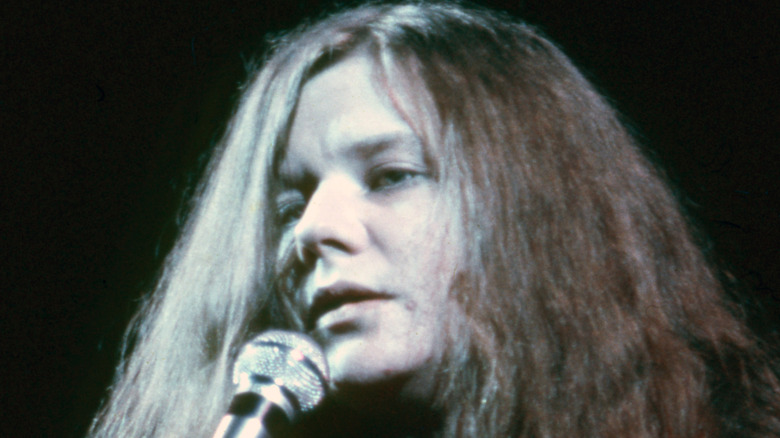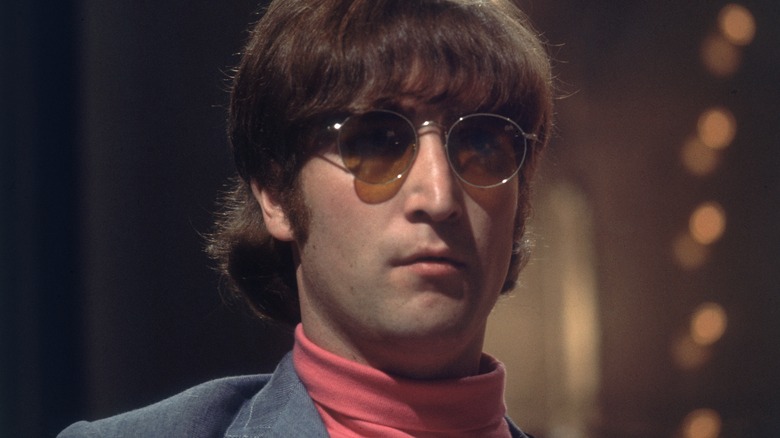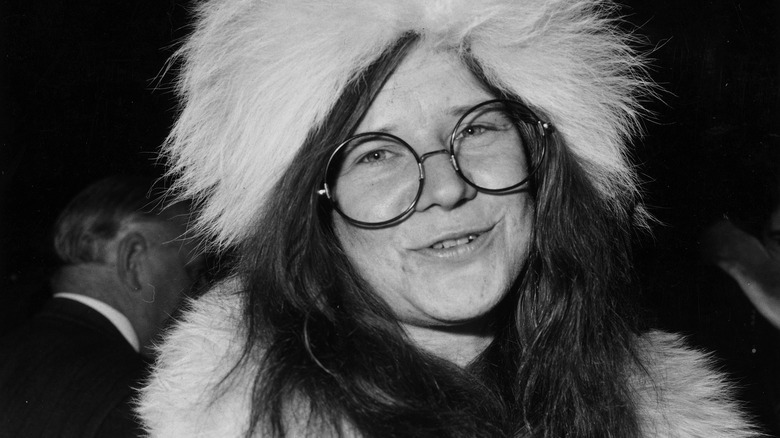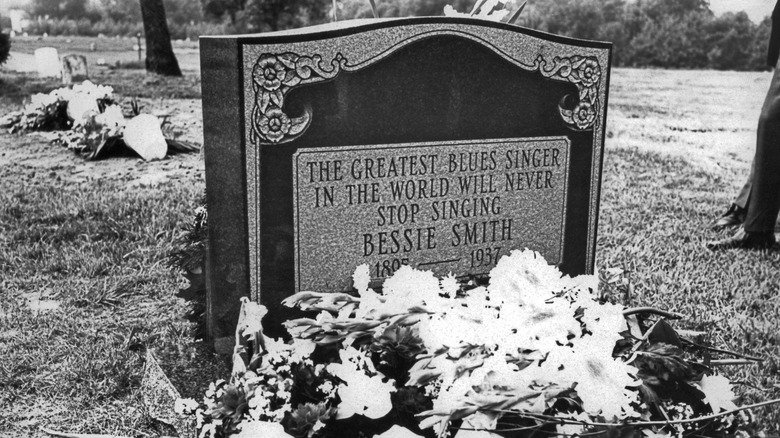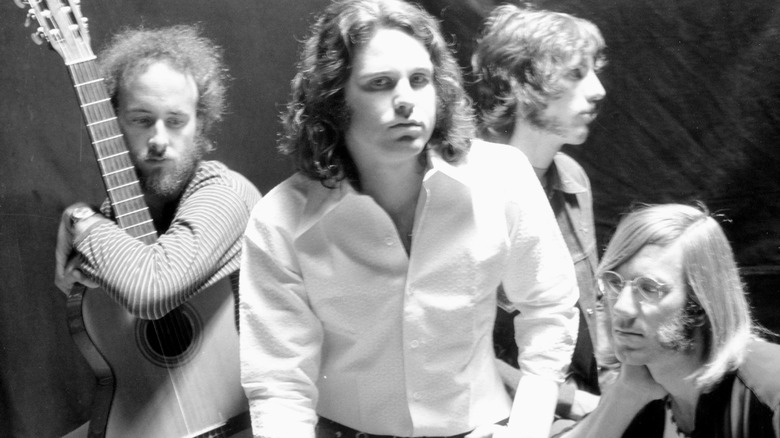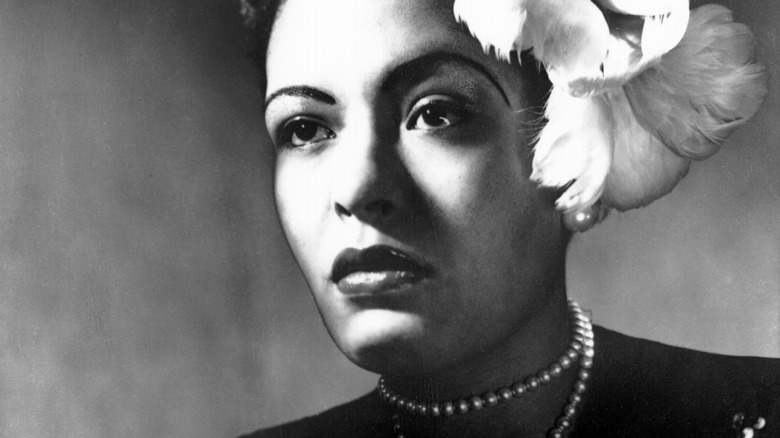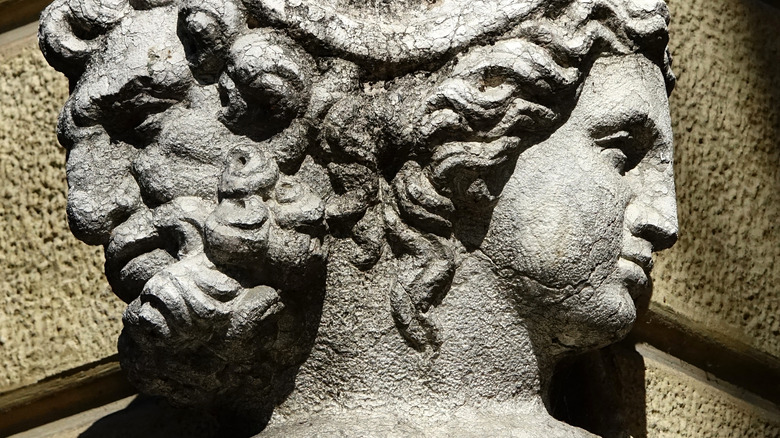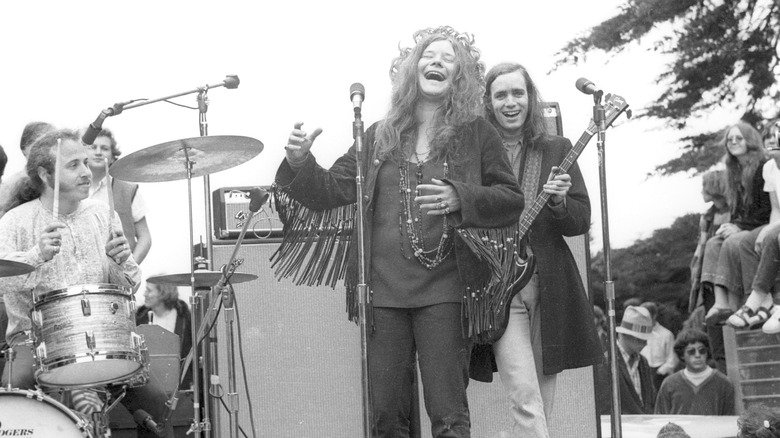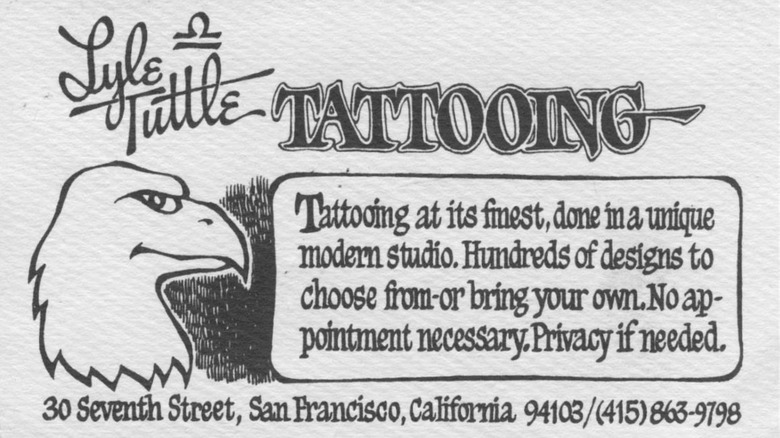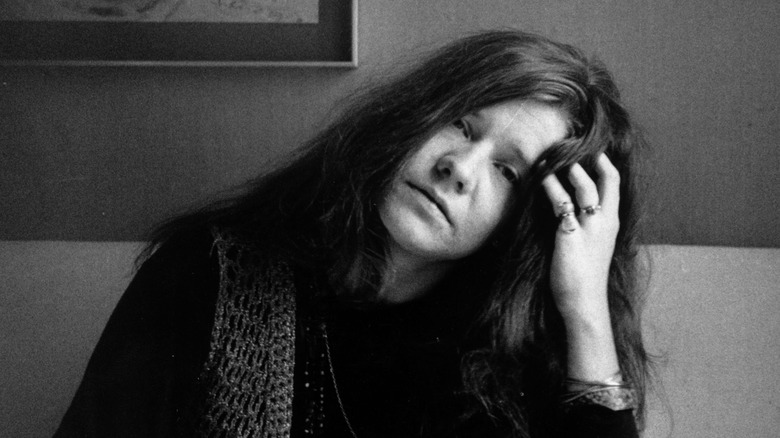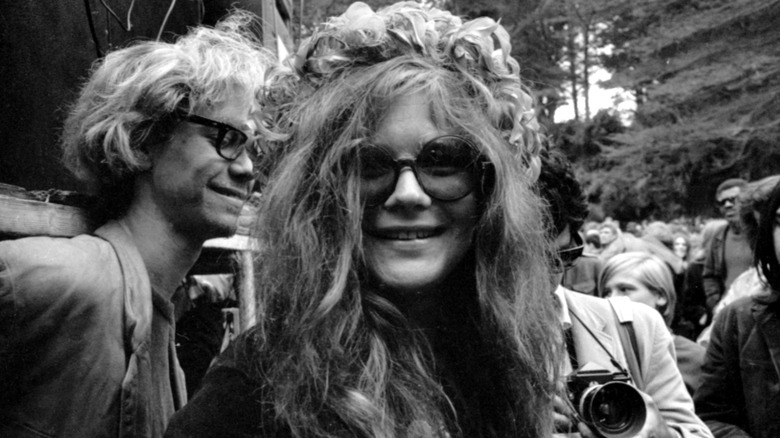The Untold Truth About Janis Joplin
On October 4, 1970, the body of psychedelic rock legend Janis Joplin lay unmoving, wedged between a bed and nightstand at Hollywood's Landmark Motor Hotel, dead from a heroin overdose (via the Washington Post). The news arrived after she failed to attend a scheduled recording session, per History. Just 27 years old, Joplin joined the infamous (and growing) "27 Club," one of the "most elusive and remarkably tragic coincidences in rock & roll history," according to Rolling Stone.
By the time Joplin joined this tragic club, it included the Delta Blues singer Robert Johnson, the original leader and founding member of the Rolling Stones Brian Jones, Canned Heat's Al "Blind Owl" Wilson, and Jimi Hendrix. The golden girl of psychedelic rock achieved overnight immortality, but it cost her everything.
According to The New York Times, three days after her death, the singer's family held an intimate funeral at the Westwood Village Mortuary. They cremated her body and scattered her ashes off the Pacific Coast as specified in Joplin's last will (via "Pearl: The Obsessions and Passions of Janis Joplin"). While much attention has been paid to the singer's untimely death, there's a lot most people don't know about Joplin's life. Keep reading for the untold truth about one of the greatest stars of the 1960s.
A birthday greeting for John Lennon marked her last recording
Rewind a few days before the shocking discovery of Janis Joplin's lifeless body in that Hollywood hotel room, and she looked remarkably lively and exuberant in a recording studio in Los Angeles, per "On the Road With Janis Joplin." Accompanied by Full Tilt Boogie, she and the band sang a riotous and triumphant rendition of "Happy Birthday" for none other than the Beatles' John Lennon. They were among a handful of musicians and bands recruited to record messages to travel across the pond.
Joplin finished the tune with her wild, signature laugh and the words "Happy birthday from Janis and Full Tilt Boogie! Happy birthday, Johnny!" From there, Richard Bell launched unexpectedly into "Happy Trails" by Roy Rogers and Dale Evans, and Joplin came in with the iconic lyrics. The energy of the recording and Joplin's carefree spirit represented the antithesis of the shadowy nightmare that would extinguish her irrepressible flame just a few sunrises and sunsets later.
The recording symbolizes a bittersweet tribute to Janis Joplin that Lennon received in the mail after learning of her death by drug overdose. Set to return to the recording studio that Sunday to add the vocals for the Nick Gravenites tune "Buried Alive in the Blues," Joplin would never make it back to the studio.
Janis Joplin was the poster child for Southern Comfort
Before her death by heroin overdose, Janis Joplin gained a reputation for hard drinking (via "On the Road With Janis Joplin"). Her drink of choice? Southern Comfort. It's little wonder an empty bottle of SoCo sat among the contents of her purse in the summer of 1970, according to "Piece of My Heart: A Portrait of Janis Joplin." You could argue that no other brand better capitalized on the whiskey-fueled blues of the Deep South to which Joplin gravitated.
As reporter after reporter mentioned Joplin's drink of choice in features and interviews with the celebrated singer, she became a poster child for the spirits. She told Mike Jahn in 1968, "I tell all the performers I meet to drink Southern Comfort because it preserves their voices. It's just an excuse for my drinking" (via The Arkansas Democrat Gazette). Joplin's SoCo obsession gave Myra Friedman, the publicist working with Joplin and her first band — Big Brother and the Holding Company — an idea. According to John Byrne Cooke, Friedman decided to make the relationship official by contacting Southern Comfort.
The brand responded, sending the singer to a New Jersey fur store to pick out something she liked. The flamboyant singer selected an iconic Russian three-quarter-length lynx coat valued at $5,000 in the late 1960s, per The Arkansas Democrat Gazette. Paired with a matching hat, these became signature pieces the singer wore at the slightest threat of cold weather.
She knew how to pay homage to her hero
Janis Joplin nursed a lifelong affection for the blues singer Bessie Smith, who died tragically in a car accident in 1937 and lay for more than 30 years in an unmarked grave, according to The New York Times. At the time of her death, the Blues singer's family couldn't scrape together enough money for a more fitting monument at the Mount Lawn Cemetery.
But in August of 1970, Joplin and Juanita Green, a registered nurse from Pennsylvania, footed the bill to have a proper tombstone erected at the grave of "The Empress of the Blues." Roughly 50 fans attended the tombstone placement ceremony where the slab featuring the inscription, "The Greatest Blues Singer in the World Will Never Stop Singing," enjoyed permanent placement. The jazz historian John Harmon wrote this epitaph, retaining fond memories from working with Bessie Smith at Columbia Studios.
As for Green, she'd made Smith's acquaintance in the 1930s at Lincoln Theater. While Joplin never met Smith personally, the similarities between the two performers proved uncanny. In "Love, Janis," she notes that Linda Gottfried, Joplin's friend and roommate, believed Joplin to be the reincarnation of Smith, from her foul mouth to her penchant for eccentric clothes and sexual experimentation.
Janis Joplin let Jim Morrison down hard
The ultimate bad boy, Jim Morrison, encountered serious trouble wooing Janis Joplin. According to "Scars of Sweet Paradise," by Alice Echols, their relationship started with a hefty dose of animal magnetism. Joplin's friend Linda Gravenites recalled that in the fall of 1967, Joplin and Morrison hooked up after dinner out with their bands and significant others. But the swinging indiscretion led to hate rather than love.
During a subsequent meeting at a party, Morrison and Joplin got into a violent altercation. Eyewitnesses later agreed that Morrison started the trouble by insulting her during a game of pool (via "On the Road With Janis Joplin"). Specifically, Howard Hesseman claimed Morrison got physical, grabbing her hair and smashing her face into a table. Whatever the case, she left the room crying only to return with a bottle of booze. Without hesitation, she brought the bottle crashing into the Doors' frontman's head. Accounts varied as to whether she threw it or kept it in her hand. Either way, she knocked him unconscious.
"Scars of Sweet Paradise" explored the two superstars' oil-and-water relationship. One West Coast booking agent Echols quoted gave this explanation: "They were two of a kind, and they hated what they saw in each other." In her book "Buried Alive: The Biography of Janis Joplin," Joplin's publicist Myra Friedman claimed her client boasted enthusiastically about gaining the upper hand thanks to a scotch bottle.
She worshiped at the altar of the Blues
Besides her Bessie Smith idolatry, Janis Joplin also devoured information about the lives of other Blues greats like Billie Holiday, according to "Love, Janis." The biography lists similarities between Joplin and Billie Holiday, also weighing in on whether they were coincidental or an attempt on Joplin's part to imitate the talent and the mayhem swirling around Holiday's musical career and personal life.
The conclusion: "Surely Janis absorbed the details of the life of a blues singer by reading Billie Holiday's 1956 autobiography, 'Lady Sings the Blues.'" The biography also noted Joplin's tendency to drink excessively and use drugs, following the examples of Bessie Smith and Billie Holiday.
According to "Buried Alive: The Biography of Janis Joplin," Grant Lyons introduced Joplin to Leadbelly, although Joplin initially preferred the Kingston Trio. But we can assume Janis Joplin's appreciation for Leadbelly matured over time. After all, The New York Free Press adoringly declared Janis Joplin the "Voice of a Lady Leadbelly" (per "Love, Janis").
Janis Joplin was named after the Roman god Janus
If you've ever wondered where Janis Joplin got her first name, look to the ancient world for answers, per Laura Joplin's "Love, Janis." Janis is a derivative of the name of the Roman god Janus, traditionally thought to reign over beginnings (including January), doorways, and archways (via Britannica). Janus worship dated to the earliest Roman times, even pre-dating the "Eternal City's" founding. Represented with two faces in sculptures and coinage, they look in opposite directions.
This double-sided persona described Joplin to a tee as she tried unsuccessfully to reconcile her stage persona with her hometown reputation. She dubbed the wild public persona "Pearl." According to "On the Road With Janis Joplin," Joplin used this "ballsy-mama-on-the-town" personality to appear outgoing and confident and also to hide a deep reservoir of insecurities she'd nursed since early childhood.
The persona of "Pearl" stood in stark contrast to the "plain-Jane" feelings of childhood and adolescence (via "Pearl: The Obsessions and Passions of Janis Joplin"). Just seven weeks before she died, she attended her 10th high school reunion in Port Arthur, Texas, and some say she never recovered from the event. Robert Rauschenberg, a fellow Port Arthur local, later recounted, "She wanted to rub ... in [her fame], and on the other hand she wanted to be loved." But as he astutely points out, these objectives proved mutually exclusive, leaving her lonely and subsumed by old insecurities by the reunion's end.
Janis Joplin proved too racy for Columbia Records
Janis Joplin got her first big break while singing with the Bay Area-based band Big Brother and the Holding Company, according to the San Francisco Examiner. The group included Dave Getz, Peter Albin, James Gurley, and Sam Andrew, who established a firm following in the San Francisco ballroom scene even before their new lead singer's arrival.
Although most people focus on Joplin's role in the group, Big Brother and Holding Company proved well ahead of their time, even before hiring the lady singer who would eclipse them. They pioneered what the San Francisco Examiner refers to as the "group's signature 'freak rock' sound," attributed primarily to guitarist Gurley. Their appearance at 1967's Monterey Pop Festival and release of the album "Cheap Thrills" in 1968 launched the group into the stratosphere of psychedelic fame.
But the album's original title was actually "Sex, Dope and Cheap Thrills," which Columbia Records found too hot to handle, according to "Buried Alive: The Biography of Janis Joplin." Fortunately for the record label, Joplin and Big Brother and the Holding Company agreed to shorten the name of their first album to "Cheap Thrills." Despite the name change, the album's success proved undeniable. It has since been voted one of the best classic rock albums in history by Rolling Stone and been inducted into the Grammy Hall of Fame, per the San Francisco Examiner.
She was a cheap thrill at Woodstock but not everyone's cup of tea
Few musical events are more "irrevocably imbedded in American culture" than 1969's Woodstock concert in New York, according to Louise Gerdes' "Woodstock." Having memories of attending the three-day festival are priceless today, and yet you could've seen Janis Joplin (and everybody else) perform at Woodstock for a measly $18.
For those in attendance, Janis Joplin took the stage "sometime between midnight and dawn Sunday morning," according to the Bethel Woods Center. Dressed head to toe in a tie-dyed velvet shirt and bell bottoms, Joplin proved one of the most enthusiastically anticipated performers of the three-day weekend. Yet, some audience members felt let down when she made her appearance without Big Brother and the Holding Company. These fans (and a handful of critics) had hoped to witness the "more raw, psychedelic rock sound of her former group."
Instead, she performed backed by The Kozmic Blues band, which she had joined after leaving Big Brother and the Holding Company in 1968. She left her breakout band at the bidding of record executives, hoping the change would steer her music in the R&B direction. Despite the new songs she premiered with The Kozmic Blues band at Woodstock, she also included a few favorites from the "Cheap Thrills" album, including "Piece of My Heart."
Janis Joplin had tattoos before they were cool
Over the past few decades, tattoos have become an acceptable way to adorn both male and female bodies, according to The Atlantic. But back in the mid-20th century, tattooed women were still employed by circuses and freak shows. Their bodily adornments represented a major taboo and were even illegal in certain parts of the country. Part of the reason for the aversion to tattoo culture remained its "association with raunchy male imagery."
Of course, this made the stigma surrounding inked females all the more shocking. The status quo believed etched images communicated loose morals, and skin art on women wouldn't start going mainstream until the 1960s and 1970s. Even then, it remained primarily associated with counterculture figures such as Janis Joplin.
Never one to let the court of public opinion sway her decisions, Joplin visited famed tattoo artist Lyle Tuttle in 1970 for a bit of ink, as reported by Inked Magazine. He decorated her outer wrist with a symbol that represented a "celebration of accepting life" (via "Love, Janis"). She also had a miniature heart tattoo on her chest, which she referred to as the "icing on the cake ... for the boys," according to Inked Magazine.
People proved cruel when it came to her looks
Before her musical career, Janis Joplin faced ridicule in her home state of Texas. "Pearl: The Obsessions and Passions of Janis Joplin" argues that Janis Joplin's life changed dramatically during the teenage years. Not only did she end up at odds with her parents, but her freewheeling ways and obsession with art didn't win her many friends at school. Coupled with physical changes, she had trouble conforming.
A childhood friend, Charlie Williams, described Joplin's awkward entrance to Thomas Jefferson High School: "She'd been cute and all of a sudden she was ugly. It was like her total self-respect had taken a broadside" (via "Pearl: The Obsessions and Passions of Janis Joplin"). A painful adolescence gave way to a graceless early adult experience. According to the Washington Post, while studying art at the University of Texas at Austin, with 20,000 other students, a fraternity had Joplin voted the "Ugliest Man on Campus."
This sealed the deal when it came to moving to the West Coast, which proved excellent for the future psychedelic scene. But it didn't lessen the pain and heartbreak she carried with her. Once on the "Dick Cavett Show," she had the following to say about her move from Texas: "They laughed me out of class, out of town, out of the state" (via the Washington Post). A genuine diamond in the rough, Joplin died before enjoying the true satisfaction of a proper hometown welcome as a famed celebrity.
Janis Joplin got arrested in her dressing room
Chaos broke out at a Janis Joplin concert in Tampa, Florida, in 1969, per Colonel William Wilson, the manager of the hall where she played (via "Pearl: The Obsessions and Passions of Janis Joplin"). The spirited singer responded to the crowd's outburst with a tirade of onstage obscenities that included a "call for disorder" directed at audience members.
By the time she retired to her dressing room after the show, a crew of police officers waited to arrest her. Charged with two counts of "vulgar and indecent language," she ended up booked at the police station just after midnight the following morning. A reporter with the Tampa Tribune would later relate that the police officers at Joplin's dressing room violated her constitutional rights by preventing her from making a statement.
Later, after arriving at the jail, she finally got to make a cheeky comment. As quoted in "Pearl: The Obsessions and Passions of Janis Joplin," she stated, "If I have to sit in jail, I would like it to be with the Rolling Stones." Unfortunately, Mick Jagger and the rest of the boys never showed up.
The deep blue sea shelters her remains
After her untimely death in early October 1970, Janis Joplin's body was cremated at the Westwood Village Mortuary in Southern California (via "Pearl: The Obsessions and Passions of Janis Joplin"). Following a private funeral with an intimate circle that included her parents and aunt on October 7, an airplane took off over the Pacific Coast near Marin County to scatter her ashes.
Public reactions to her untimely passing varied greatly. For example, in her hometown of Port Arthur, Texas, the local newspaper featured an obituary emphasizing the fact she never performed in her hometown and "visited only infrequently." This brings to mind the New Testament wisdom, "The only place a prophet isn't honored is in his hometown" (via Matthew 13:57). Apparently, it extended to self-stylized female blues singers, too.
Others saw her death as a cautionary tale, and a significant nosedive in heroin happened. The timing of her demise, a fortnight after that of Jimi Hendrix, also inspired some fans and members of the media to connect the two tragedies. The fact both performers had been linked romantically only served to underscore the association (via Alice Echols' "Scars of Sweet Paradise"). An editorial in The New York Times read, "The king and the queen of the gloriously self-expressive music that came surging out of the late sixties are dead, the victims, directly or indirectly, of the very real physical excesses that were part of the world that surrounded them," as quoted by "Pearl: The Obsessions and Passions of Janis Joplin".
